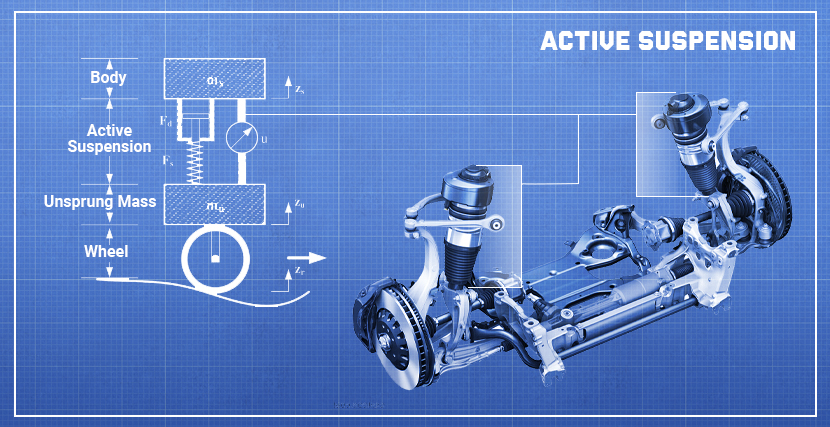Active Suspension
An active suspension system is an advanced computer-operated system, which allows for the precise control of up and down movements of the wheels and the vehicle’s body for smoother ride and better handling road imperfections. Unlike standard passive suspension systems, their active counterparts have an ability to analyze road imperfections and to change the clearance as well as to adjust other suspension settings on the go to handle all pavement irregularities more efficiently.

While most cars on the road are not equipped with active suspension, it has gained popularity in the luxury vehicle and sports car segments. Today, just about every newer sports car, including Chevy Camaro or Ford Mustang, comes with an active suspension system. However, contrary to popular belief, active suspension isn’t a product of the new millennium. It was introduced in the late 1954 in France with the Citroen DS model. Other automotive giants like Mercedes-Benz also made attempts to make their suspension systems smarter, providing their own active suspension system designs.
Like most other advanced vehicle systems, active suspension became popular due to its usage in Formula 1. Despite the fact that it was shortly banned, thanks to Formula 1 automakers continued to develop active suspension, creating advanced computer-controlled active suspension systems for their high-end cars. They can be found on many BMW, Toyota, Mercedes-Benz, and Land Rover vehicles produced in the 1980s. Today, active suspension systems are offered as standard or additional equipment for high-end Audi, Mercedes-Benz, Porsche, and Nissan vehicles. It can be stated with confidence that active suspension will find its way to the affordable vehicles market in a couple of years.
When we talk about automotive suspension, we imagine a complex arrangement of coil springs, shock absorbers, etc. Active suspension is even more complex. It has a different design and features a more advanced type of springs and shock absorbers. A special control module constantly monitors the movements of the vehicle and scans road imperfections to adjust the suspension system to prepare the vehicle for the challenges. A typical active suspension system allows for adjusting the vehicle’s ride height and stiffening or softening the suspension. Newer vehicles also provide the driver with selectable settings to address different road conditions.
An active suspension system gives a driver an array of benefits over regular suspension systems. Thus, the latest models come with a back-viewer camera, which allows the suspension control module to see all bumps and potholes on the road before the vehicle hits them. Depending on the obstacle, the computer can raise a specific wheel or the entire vehicle to tackle the bump or pothole. As a result, the driver can enjoy a smooth ride regardless of the road conditions. The other benefits of utilizing an active suspension system include:
- Smooth ride without body roll
- Lower ride height at higher speeds
- Controlled ride height while off-roading or carrying a load
- Braking assistance
- No rear-end squat during acceleration
Signs your active suspension system is about to fail
Problems with an active suspension system can keep it from controlling the vehicle’s ride, which, in the worst-case scenario, can lead to an accident. To void such an experience, we made a list of the most common warning signs of a bad active suspension system you should pay attention to:
- Abnormal sound when hitting bumps or potholes
- Hissing noises on vehicles with air springs
- Suspension warning light is on
- One side of the vehicle is higher than the other one
Active suspension troubleshooting and replacement
An active suspension system is very complex. It contains both mechanical and electrical components which require sophisticated skills and a special knowledge to deal with. Your mechanic will need to use a special scan tool to check the electrical part of the system and specific equipment to inspect all mechanical components. Once the problem is detected, the mechanic will be able to fix it by replacing faulty parts or components. In some cases, a wheel alignment may be required to complete the repair.
We recommend you neither to diagnose nor to repair a bad active suspension system yourself. Both tasks should be left to a professional who understands all aspects of the suspension operation and has all necessary scan tools and equipment required to do the trick. He or she may also need to disassemble suspension parts and components, and then to reinstall them in the reverse order.
{{_shortcode_category_105_}}